
NAMGAR's GT-31 in 2006 is now history. We managed to pack a lot into our travels to and from the event. And although the event itself had its moments, in general, we had a good time. As you'll read later, the Gatlinburg of the the 2000s, is not the Gatlinburg of the 1970s, nor is it even close to the Gatlinburg of the 1940s.
If you needed a T-shirt, there was no shortage of businesses to accommodate the need!
Starting the Trip
As usual, we left home very early to avoid Chicago traffic. Our first stop was in Three Rivers, MI, where we spent the night with Bruce Nichols. The real trip began on July 19th when the four of us, Bruce, his daughter Robin, and we headed south towards our first night's stay in Danville, KY.
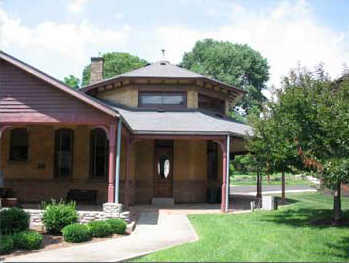
Railroad Depot & Museum, Madison, IN
Traveling through Indiana is usually uninteresting. It's flat, open farm land and a long way from the northern to the southern borders. Somewhere around Greensburg, we encountered two MGAs, a roadster and a coupe, pulling out of a gas station, along with a mini-van . When we got to a traffic light in the next town, the MGA coupe pulled along side PRNCZ on the right. The driver stuck his head out: lo and behold, it was Peter Alberda from Zeeland, MI. Peter and Jan had the Alberda clan in-tow and were heading to MG2006. Somewhere further down the road, they turned east while we continued on our route.
Eventually, we made it to our first stop: the railroad depot in Madison, IN. Why would anyone want to stop in Madison? For one thing, we'd been in the cars for a good portion of the day with stops only for gas and food. It was time to sight see, and what better thing to see than a restored railroad depot with an octagon rotunda.
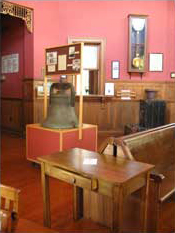
Railroad Museum Interior
Madison is a picturesque town on the banks of the Ohio River. It was the transportation and manufacturing hub of Indiana, before there was a burg called Indianapolis. The historical section of town includes the depot and an historical museum, along with other small shops and restaurants.
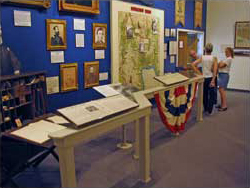
Historical Museum Exhibit
During our visit, the depot was locked, so a docent was required to open it. The docent filled us in on the restoration effort, the displays and some of the artifacts. This is a very nice restoration with a number of interesting displays and artifacts about Indiana's first railroad, the Madison and Indianapolis
The historical museum has displays describing life in Madison during its heyday. The exhibits are interesting and informative with one wall dedicated to button manufacturing in the 1800s. In the picture to the right, Bruce, Diane and Robin discuss the strategic significance of Madison during the Civil War. There is a section of the museum dedicated to the local geology. That you can skip unless you happen to be a geologist. It's worth visiting Madison just to drive down the hill on Michigan Road towards the river.
Now, over the bridge crossing the Ohio River and on to our next stop: Danville, KY.
A Day In Shaker Village, A Night in Danville
You just have to love the Kentucky back roads. They were made for MGs on sunny days. They run along ridge tops, next to streams and it seems that there are always vistas of green hills. There is an inside joke between the ole time Michigan Rowdies and a fellow named Al Rossi from New Jersey about Baghdad, MI. There is no such place as Baghdad, MI — but we can attest that there is a Baghdad, KY because we drove through it! We pulled into Danville late in the afternoon. Because of map problems and navigational issues, it took us a while to find the motel.
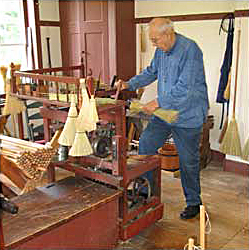
Shaker Broom Making
We scheduled a complete day in Danville because we wanted to visit Shaker Village in nearby Pleasant Hill. Touring Shaker Village takes the better part of a day, if you devote some time to everything that's there.
Shaker Village is a living history museum where re-enactors demonstrate the lifestyles and traditions of the Shaker people. The village was founded in 1806. The last Shaker, Mary Settle, passed away in 1923. Shaker Village was restored in 1961. The name Shaker comes from their practice of vigorous movement during their worship services.
By our standards, their lives were extremely austere. The picture below shows a typical Shaker room. The men and women were segregated. Children roomed with the women. Once a man, woman or family joined the Shaker community, they took a vow of celibacy.
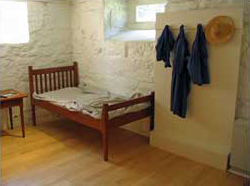
Typical Shaker Room
They were an extremely industrious and inventive people. The re-enactor in the picture on the right is making brooms. The sweep is built up from layers of straw around a wooden handle. Each layer is bound by metal wiring using a foot operated banding machine.
The work in the village was divided amongst the membership. There were wash houses for laundry; a cooper shop for the construction of pails and barrels; a pump house for raising and storing water; along with a number of other buildings, including a post office.
The meeting house was most impressive. Here the entire community gathered to worship.
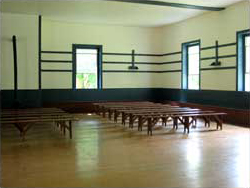
Shaker Meeting Room
Men and women entered the building and sat on opposite sides of the room. Visitors sat along the walls. The center was used for ministering, singing and dancing. During our visit, a re-enactor gave a twenty minute presentation on the history of Shaker worship: its songs and the dances.
She had an unbelievably beautiful voice that echoed in the hall and out into the village. This drew others into the hall, and by the time her presentation was complete, the hall was nearly full.
To get their supplies and products to market, the Shakers used a stern wheeler on the Kentucky River not far from the settlement. Today as part of the experience, you can ride a stern wheeler, the Dixie Belle, which takes you on a one hour excursion. Yup, we did that, too.
Late in the afternoon we headed back to Danville where we did a bit of antiquing. Diane noticed that the fuel gauge wasn't registering. We'd seen that before and chalked it up to the heat. Then Robin mentioned that we didn't seem to have any brake lights. A quick check confirmed that and the fact that there were no turn signals either. On the way back to the motel, we stopped at an auto supply store so Bruce could by some oil. Steve picked up a cheap test lamp.
As Steve starting testing, he discovered that the cheap test lamp had a bad lead that required repair. All tests indicated the electrical problem was near the circuit's fuse. But the fuse wasn't blown. By-passing fuse with power from another source fixed the problem. Bruce was playing with the fuse when an end cap fell off in his hand. A new fuse, and everything worked. It actually took longer to fix the cheap test lamp, than it did to repair the problem!
We had tickets for that evening to My Sister Eileen at the Pioneer Playhouse. The Pioneer Playhouse is the longest, continuously running, community theater in the U.S. For $25.00 a head, you got dinner and a show. We arrived a bit early and were standing in the parking area shooting the breeze with the parking directors when a lady approached us and said, "Oh, my god, those are MGAs!" After some chit-chat, it turns out she's the costumer for the play and had owned an MG-TD and an MGA in the early 60s. She gave us the low-down on the theater and took us backstage for a tour of the various departments. The ticket booth was the railroad depot prop from the movie Raintree County, so there were a number of photos and memorabilia about that movie's stars: Elizabeth Taylor, Eva Marie Saint, and Montgomery Clift. Pioneer Playhouse also boasts of its famous alumni, Lee Majors and John Travolta.
Lest you think this was an academy award evening, the theater was showing signs of its age. It was an outdoor amphitheater arrangement constructed from paving bricks with plastic lawn seating. The dinner was fried chicken or pulled-pork with plastic tableware. The dinner entertainment was unbelievable. Just ask Diane. However, we can say we had a good time. The actors were enthusiastic — most were recruited from NYC for the season. My Sister Eileen is a comedy, and the audience was in stitches the entire time. Since this was mid-week, the audience was decidedly older than us. We had fun. What more can you say?
All Aboard in Stearns

Central Nickel Age Touring Club
We left the motel early and headed south to the rail head in Stearns, KY. The Big Southern Scenic Railroad left the Stearns station at 11:30AM, and we needed to be on it. The Big Southern takes you on an excursion into coal country, along the rail that once serviced the coal mines in the area.
When we arrived in Stearns, we met the Central Nickel Age Touring Club. They were on a four day tour of the Cumberland area. There were probably thirty cars in the group ranging from the early 1920s to the late 1930s. We saw Fords, Pontiacs, Dodges, Appersons, Monroes and Maxwells, to name a few.
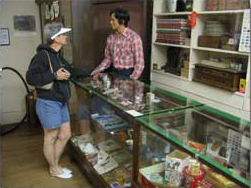
How Much for the Bolt?
While we were waiting for the train to pull out, we visited the local Historical Society Museum to learn more about the area.
Stearns was actually founded by Justus Stearns from Ludington, MI, in 1902 (go, Rowdies). There are a number of displays about the mining and lumber industry, local crafts, local heroes and events. In the section on local commerce, Diane stopped to ask the man behind the counter about the price of bolt material: he seemed a bit stiff.
The Big Southern runs on the original tracks of the Kentucky & Tennessee, founded by Stearns to service the mines and logging camps of the area.

Big Southern Scenic Railroad
As you travel through the countryside, a narrator describes the scenery and tells you about each of the mine sites you pass through. All mines have been closed for decades either through disaster or the decline of mining in the area. The entire tour is 3.5 hours. This includes a stop at the Blue Heron Mine, reconstructed and run by the National Park Service.
The Blue Heron is no longer a working mine. The National Park Service has constructed a town of "ghost" buildings: essentially, framed structures representing the original buildings on the property.
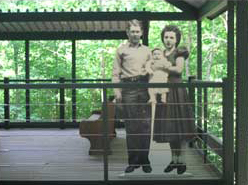
Ghost Building and Family
Inside are usually pictures and narrations of the family or business that occupied the structure. Often the narration is provided by people who actually lived here when the mine was active. Steven lived in eastern Kentucky for a little while in 1957. Although he didn't live in a coal mining town, he lived in coal country and can attest to the lifestyle and poverty of the period.
There are paved trails through the park, and you can walk across the mine's tipple, a small bridge used to convey trams filled with coal from the mines to the railhead where the trams "tipped" their load into the waiting coal hopper cars below.
There is a mock-up of the entrance to the Blue Heron mine, but it does not convey the true experience of entering a mine. And true to a national park experience, there is a food concession and gift shop nearby.
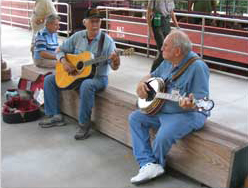
Pickin' & Grinnin'
At the Blue Heron, the train's engineer, conductor and another volunteer plunk down on the benches outside the gift shop, pick up a guitar or banjo and commence to singing. We swear, we heard almost every song from the coal mining era in the hour, or so, that they played. If you're in the area, interested in history, like trains and have 3.5 hours to spend, consider taking a ride on the Big South Scenic Railway.
By the time we got back to the cars, it was about 2:00, and it was hot. We waited around for a while to let all the other tourists clear out. Then we continued south to Gatlinburg. We ran into some rain and decided to put the hood up. We also missed a turn somewhere and needed to figure out an alternate route. While the back roads of Kentucky are great drives, they're often not well marked. Ultimately, we found Rte 321 which took us to Pigeon Forge. A couple of wrong turns in Pigeon Forge put us at the entrance to Dollywood, but we eventually made it to the hotel in Gatlinburg.
Our Time at MG2006

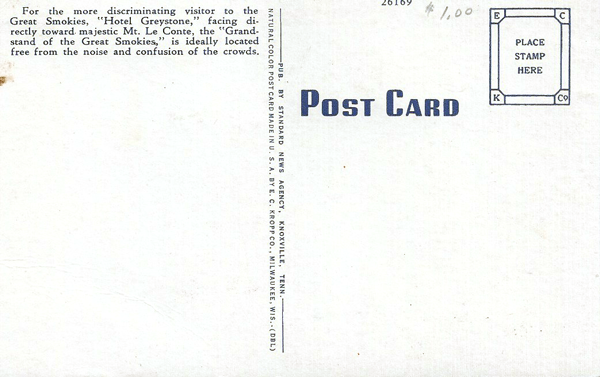
On The Back
Mouse Over to Read Back
When we first visited the Great Smokies in the mid-1970s, we stayed at the 20-unit, Riviera Motel in Pigeon Forge. Then, Pigeon Forge was a sleepy town on a lazy four lane at the west entrance to the Smokey Mountains National Park. Surprisingly, the Riviera Motel is still there. Now, of course, it appears to be 120 units surrounded by water parks, pancake houses, any number of arcades and attractions, in addition to a six lane divided high-way with numerous and numbered traffic lights. Now Pigeon Forge is also the home to the Dollywood theme and water parks.
Gatlinburg has also gone through transformation. While it has always been crowded, it has now added more attractions in the same amount of space. The sequence along the Main St. seems to be T-shirt shop, pancake house, arcade, hotel, T-shirt shop, pancake house, etc. The Greystone Motel, shown in the 1940s postcard, still existed as late as 1995 from information gathered from locals. The inscription on the back of the postcard is especially poignant:
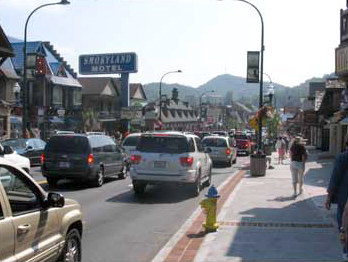
Mid-morning in Gatlinburg
Contrast the postcard inscription with a picture of Gatlinburg at 10:30AM on a weekday morning.
Today, Ripley's Aquarium stands at the site of the Greystone: serenity and golden memories are replaced by SUVs and mini-vans.
Enough whining about the venue and more about the trip and GT!
The nice thing about the Gatlinburg venue is that the planners booked all the hotels within walking distance of each other and the banquet facilities. With the exception of the car show, you were not required to drive to anything unless you were attending the optional trip to the Biltmore Estate or wanted to drive in the mountains.
The car show was held at the park in Cosby, about twenty miles from Gatlinburg. The space was a bit cramped, but there were food, drink, facilities, grass and trees. What more could you ask for? Although it was cloudy and threatened rain, while we were there, there was nary a drop.
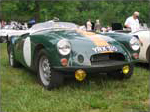 YRX 310 Race Car |
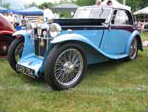 Rare PA Airline Coupe |
 K2 Racer |
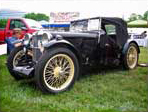 J2 |
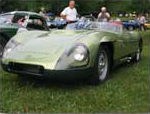 Experimental EX-186 |
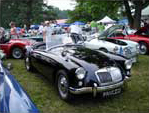 PRNCZ |
 Tickford Coached MG |
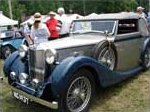 VA Saloon |
As far as we know, there was no official count of the cars on the field. The estimate was given at approximately 1300 MGs: the MGBs had a good portion of the field. There were MGs there for everyone's tastes, including MGAs outfitted with V8 engines and a pink MGB that survived hurricane Katrina. The owner pointed out the water line across the side of the vehicle. We left about 3:30 because we were recruited to help with NAMGAR's First-Timers' event and later the NAMGAR sponsored meet-and-greet buffet.
The meet-and-greet event was held at a local restaurant that had a modest sized meeting room. The plan was to have the munchies and beverages in the room, and the attendees would spill out into the surrounding lawn to chat. Tents with tables were set up to provide additional sitting. But the clouds gathered, the skies darked, and a deluge ensued. People crowded into the food area. You couldn't get to the food, and, if you had it, you couldn't get it to your mouth because your arms were pinned to your side. Normally, these mountain showers last only a few minutes; this one lasted over three hours. Eventually, the facility management opened another room in the main building. But to get food or beverage, you had to brave the storm. The best laid plans...
We'd done our share of hill driving, and we'd seen the Biltmore, so we were content to hang around the hotel, chat with folks, browse the MG2006 vendor area and wander through the local shops.
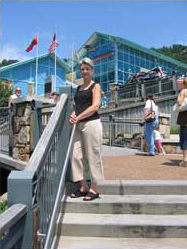
Diane at Ripley's Aquarium
Diane wanted to see Ripley's Aquarium. The aquarium, besides the usual fish tanks, has a glass tunnel that passes through the major tank in the building. We're told this is similar to other aquariums like Sea World. While in the tunnel, you can see all manner of fish swim by, including several species of sharks. We spent a couple of hours wandering through the exhibits. They had a petting zoo, but Steven couldn't get Diane to play with the horseshoe crabs or the manta rays and skates.
Diane scoured the shops and small off-street walking malls. Steven was looking for a pharmacy. The evening before, a gold crown fell out at the NAMGAR meet-and-greet; he needed some tooth putty to fill the hole until he returned home. He didn't think duct tape would work well.
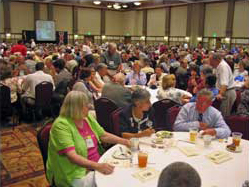
MG2006 Banquet Room
We tolerated the crowds, eventually stopping at a local brewery for a quick snack and a drink to celebrate Diane's ##th birthday.
The main banquet was held that evening in the Gatlinburg Convention Center: a very large facility. The dining room sat well over 2000 attendees. The meal was buffet style, and to get your food, you were directed to another banquet room where there were four long rows of tables. Each row served one of the meal choices. The fourth contained nothing but desserts.
This was the most efficient set-up we've ever encountered. Yeh, you had to walk to get your meal, but the food was hot and there was enough to feed everyone, some twice. The awards were dispatched quickly and efficiently. The only real grumbling was heard during the auction held prior to the banquet. Everyone thought it was to be a silent auction. But when the caller started, you couldn't hear yourself think for the next 60 minutes.
After the banquet, we headed back to the hotel to chat a bit more and then to bed. We had an early start the next morning for our return trip home.
Heading Home
Bruce, Robin and we started out early to avoid any congestion in Pigeon Forge. We headed north through eastern Kentucky. It threatened rain all morning, but we didn't encounter any until we passed through the Cumberland Gap. Diane and Steven were running with the hood down when the skies opened up. Unfortunately, there was no place to pull off. The motorcyclists had all the overpasses occupied, and stopping along side the road meant getting wetter than continuing on. Eventually, the rain let up, so we pulled over to put up the hood. Somewhere around Booneville the wiper motor stopped working. It was raining steady and hard, so we spent some time in a local diner. It rained pretty much the rest of that day.
We were on a scenic route that took us on a portion of the Red River Gorge Scenic Byway. Along the route, we passed through the Nada Tunnel. Hand carved to make a road for the logging trucks back in the early 1900s, the Nada Tunnel is on the National Register of Historic Places because of its unique nature. Two teams began in 1910 on each end and worked their way to the middle using steam powered jackhammers and carbide lamps. This 900-foot tunnel is for one-lane traffic only and is a very unique way to enter the Red River Gorge. It's like no other tunnel we've ever passed through, because it was only sightly wider than PRNCZ!
The roads along our route were unbelievable. Even going up hill in second, you had to keep your eyes and attention on the road. We passed through several coal mining areas, and all I can say is I'm glad it was Sunday. The last thing I would have wanted to encounter were loaded coal trucks on these roads!
Our stop for the night was in Maysville, KY. We unpacked, cleaned up and walked across the street to a local Mexican restaurant.
The next morning, 7:00AM, we were on our way again. In Hillsboro, OH, we stopped for gas and said our farewells to Bruce and Robin. They were headed back to Three Rivers, and we were going on to Columbus to spend time with friends we hadn't seen in years.

Elizabeth Taylor Rose
We lived in Columbus for a while in the late 1970s, so during our visit, we investigated some of our old haunts. Most were no longer recognizable. The one place near where we lived, however, never changes: the rose gardens at Whetstone Park. We spent an hour, or so, just wandering through the gardens and enjoying the quiet.
After three days with our friends, it was time to head home. We drove the National Highway (US Rte 40) to Richmond, IN, and spent a day in the area antiquing. Diane was excited to find a piece of the amber Tiara glass she didn't already have.
The next day we headed home. We thought we'd be smart and drive west of Chicago until we hit Rte 47, then follow that north until we were due west of the house and then turn east. What we hadn't counted on was the new construction southwest of Chicago. The housing is going up so fast that the local roads can't keep up with the new traffic. A drive that should have taken only two hours, ended up being four. So much for a better way...
We did finally make it home safe and sound. With the exception of the wiper motor (which is now repaired), PRNCZ ran well. We had a good time at the GT, and the trip was relaxing. What more could you ask for?
Diane already has the hotel booked for GT-32, and Steven is working on the itinerary. Hopefully, gas prices won't climb much higher, or it will be cheaper to fly than drive (oh, no!). See you on the MG Drive with Altitude in Whistler!

